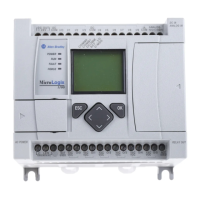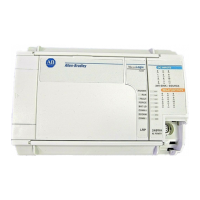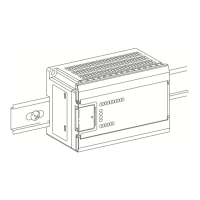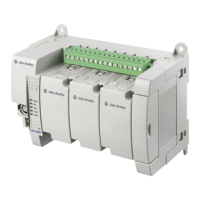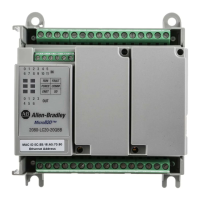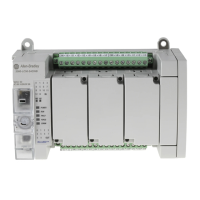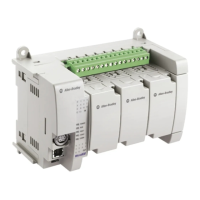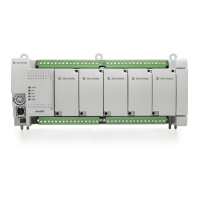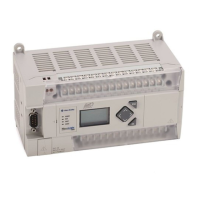
Do you have a question about the Allen-Bradley MicroLogix 1400 and is the answer not in the manual?
| Processor | 32-bit |
|---|---|
| Expansion Modules | Up to 7 expansion I/O modules |
| Power Supply | 24V DC or 120/240V AC |
| Programming Software | RSLogix 500 |
| Communication Ports | Ethernet, RS-232/RS-485 combo port |
| Controller Type | Programmable Logic Controller (PLC) |
| Series | MicroLogix |
| Digital Outputs | 12 |
| Analog Inputs | 6 (embedded) |
| Analog Outputs | 2 (embedded) |
| High-Speed Counter | 6 high-speed counters |
| Pulse Output | 2 (embedded) |
| Ethernet Port | Yes |
Details built-in discrete and analog I/O points.
Information on attaching expansion I/O modules and addressing slots.
Explains the I/O addressing scheme and provides examples.
Details on 4-channel, 12-bit resolution analog inputs.
Configuration of inputs for pulse catching and latching behavior.
Description of data files for storing numeric information and I/O status.
Feature for updating ladder logic without destroying user-configured variables.
Prevents modification of file values via communications except during download.
System for securing the controller with numeric passwords.
Provides year, month, day, hour, minute, and second information.
Read-only file containing information on communication parameters and activity.
Read-only file containing information on embedded and local expansion I/O status.
Lists programming instructions by functional group and page number.
Describes immediate, direct, and indirect data addressing methods.
Details the six 100kHz high-speed counters and their inputs.
Explains configuring HSC for PLS or rotary cam switch operation.
Instruction to control and monitor physical high-speed outputs for pulse train generation.
Instruction to control and monitor physical high-speed outputs for PWM waveform generation.
Instruction to monitor a bit for an ON condition.
Instruction to monitor a bit for an OFF condition.
Instruction to turn a bit location ON when rung conditions are true, OFF when false.
Explains timer files, elements (control, preset, accumulator), and time bases.
Instruction to delay turning on an output when rung conditions become true.
Instruction to delay turning off an output when rung conditions become false.
Tests if two values are equal.
Tests if one value is not equal to a second value.
Tests if one value is greater than a second value.
Lists output instructions for computations.
Adds two values and places the sum in the destination.
Subtracts one value from another.
Multiplies two values.
Divides one value by another.
Decodes a 4-bit value into a 1-of-16 bit destination.
Encodes a 16-bit source to a 4-bit value.
Converts BCD to integer.
Performs a bit-wise logical AND operation.
Performs a logical OR operation.
Performs a logical exclusive OR operation.
Inverts the source bit-by-bit.
Copies words of data from one location to another.
Copies a range of data from one file to another.
Loads a file with a program constant or value.
Loads and unloads data into a bit array one bit at a time.
Loads words into a file and unloads them in FIFO order.
Compares masked source words with masked reference data.
Transfers masked source reference words to destination.
Changes program execution order by jumping to a labeled rung.
Jumps to a designated subroutine and returns.
Ends the program scan or subroutine.
Updates input data prior to the normal input scan.
Updates output data prior to the normal output scan.
Fundamental properties of user interrupts.
Details interrupt instructions and their function files.
Mechanism to solve time-critical control requirements.
Describes PID instruction for controlling physical properties via process loops.
The core PID instruction for controlling process variables.
Table showing input parameter addresses, data formats, and types.
General information about ASCII instructions and their function.
Arranges ASCII instructions with write preceding read.
File used by ASCII instructions to store ASCII character data.
Information about MSG and SVC instructions.
Instruction to transfer data between devices.
Controller's capability for communicating using local or remote messages.
Steps to configure a local message.
Steps to configure multi-hop remote messages over Ethernet/IP.
Allows communication with Ethernet devices not supporting EtherNet/IP.
Implemented via Socket Object in Ethernet Subsystem.
Describes UDP and TCP socket types.
Saves custom lists of data associated with a recipe.
Captures and stores application data for later retrieval.
Steps to configure data logging queues.
Triggers the saving of a record.
Using the LCD functions to monitor and modify data.
Provides access to LCD and Trimpot configuration data.
Lists memory usage and execution time for programming instructions.
Lets you monitor controller operation and direct its behavior.
Details arithmetic flags, controller mode, and other status.
How to determine and correct faults.
Lists fault messages, error codes, probable causes, and corrective actions.
Describes DH-485 network functions, architecture, and performance.
Point-to-point connection combining data transparency and simultaneous transmission.
Multi-drop single master/multiple slave network.
Shows configuration parameters for Modbus RTU.
Provides connection to other ASCII devices.
Supports Ethernet communication via Channel 1.
Guide for using PTO function and generating pulses.
Guide for generating waveforms at specified frequency and duty cycle.
Details the six 100kHz high-speed counters.
Mechanism to solve time-critical control requirements.
Captures and stores application data for later retrieval.
Explains 16-bit binary numbers and their decimal values.
Explains hexadecimal numbers and their decimal equivalents.
Identifies a memory location.
Machine or process monitored/controlled by a controller.
Standard for defining codes for information exchange.
Speed of communication between devices.
